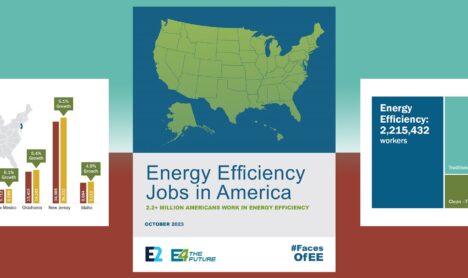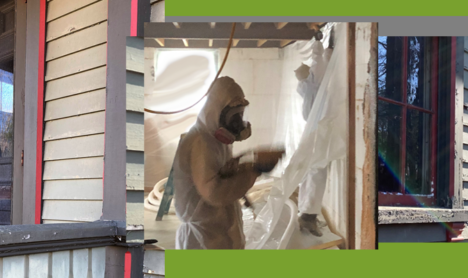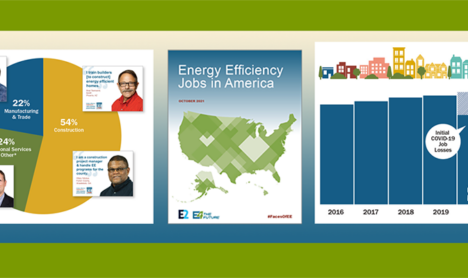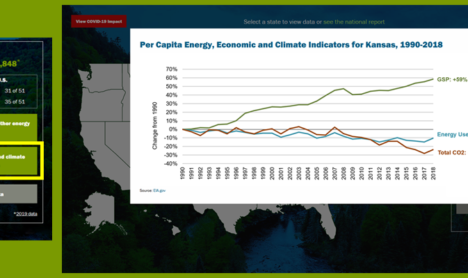Posts Categorized: Policy
-

Navigating Uncertainty: Staying Motivated and Inspired by the Growth of Energy Work
by Aileen Villa
“Uncertainty” is probably the single word that I’ve been hearing the most these days in the weeks after the 2024 presidential election. I hear it on work calls about strategy and attempts to set expectations in the energy industry, from concerned small business owners, on phone calls and hangouts with friends, and while having meals with family. Yet, it always resonates.
It helps to be active in my communities and keep my mind occupied with other tasks like reading speculative fiction, though it’s also helped to focus my attention on other maybe seemingly small wins (that I know will have a huge impact!).
-

The U.S. Energy Efficiency Workforce: Deep-Dive Annual Insights
by Pat Stanton
I’m proud of my team’s work on our seventh annual energy efficiency (EE) jobs report. Energy Efficiency Jobs in America in 2023 shows 2.2+ million efficiency workers, a number expected to grow annually with new workforce development and training happening across the country. This report focuses on the specially trained builders, electricians and other skilled professionals who focus on making our buildings, appliances, factories and infrastructure run on less energy.
Providing access to consistently-presented EE workforce statistics at regular intervals during this crucial time serves as a key baseline for comparison, as public and private sector infrastructure investments continue to rise.
-

Unparalleled Opportunities Arise for Energy Efficiency Job Growth: Report
by Pat Stanton
Energy efficiency (EE) initiatives are needing increased attention with new federal funds. This translates into more jobs on the way. Energy Efficiency Jobs in America shows there are nearly 2.2 million efficiency workers, and the number will rise as infrastructure investments kick in this year. Making these workforce statistics available now is important, so that we have a baseline for comparison.
-

It’s Now or NEVI
by Susan Buchan
Are states, cities and towns prepared for the new electric vehicle infrastructure funding?
When Congress passed the Bipartisan Infrastructure Bill in November of 2021, it made history for including the largest-ever federal investment in transportation electrification. One section of the law, the National Electric Vehicle Infrastructure (NEVI) Formula Program, will provide $1B each year from 2022-2026 “to provide funding to States to strategically deploy electric vehicle (EV) charging infrastructure and to establish an interconnected network to facilitate data collection, access, and reliability.” Read More
-

Weatherization Without Walkaways: Change is Coming, But Needs a Push
by Steve Cowell
Weatherization is in the news more than ever, with infrastructure funds coming and with state and federal legislation proposed to improve buildings.
Funding is necessary, but not sufficient, to solve our nation’s crisis in substandard housing. We absolutely need smart strategy. If we do not apply funds quickly and effectively, this opportunity could turn into its own crisis. This is what keeps me up at night.
-

With Building Efficiency Retrofits, You Really Can Have It All
by Carina Wallack and Pat Stanton
Care about economic and environmental well-being? If so, you realize that our most valuable assets are sectors that create jobs quickly while cost-effectively reducing emissions for the long haul. Building energy efficiency investments accomplish this and more.
Read More -

Energy Efficiency Jobs in America 2021: The Power to Tackle Our Thorniest Issues
by Steve Cowell
Energy Efficiency Jobs in America explores the workforce that comprises the largest part of U.S. energy sector employment. It also shows how energy efficiency has the breadth and depth to tackle our thorniest issues. Efficiency holds the promise of solutions for climate, equity, and economy.
Energy efficiency businesses across the country were gutted by the pandemic. They continue to be impacted by economic and workforce challenges. Yet day after day, efficiency workers — who are unsung heroes — rise to give their best effort. Read More
-

Energy Independence in a New Light: Economy Grows, Yet Uses Less Energy
by Pat Stanton
Throughout the 19th and 20th centuries, conventional wisdom equated economic growth with a rise in energy use, across the board. An examination of trends over the past three decades, proves that the correlation is no longer valid.
A Synapse Energy Economics analysis of data from the Energy Information Agency (EIA) recently commissioned by E4TheFuture compares per capita economic growth, energy use and CO2 emissions nationally, and for each state and the District of Columbia.
Read More -

State-Level Policy Choices Matter (a lot!) for Climate
by Steve Cowell
At this moment federal leadership changes are center stage, and may likely bode well for U.S. action on climate. Yet I want to focus beyond national news, calling your attention to a simple fact: States and cities need to remain at the forefront of implementing climate solutions.
Think of it as a “both/and” approach: Policy choices and implementation decisions by state officials as well as city leaders will help to move us forward, and can complement and execute positive federal legislation while administering programs. For meaningful U.S. progress on climate change, cooperation by and within states must be prioritized. Read More
-

Emissions Optimized Charging for EVs (Part 1): Should “What” Matter More Than “When”?
by Susan Buchan
Are we on the verge of an EV “tipping point” similar to other technological advances that found rapid acceptance and integration into the marketplace? Projections show the rise of electric vehicle adoption in the US is positioned to continue and increase. Historical data show refrigerators, clothes dryers, color TV, personal computers, and smartphones all rose from early-adopter status to widespread diffusion and ownership in about ten years.* Read More
-

Veterans Show Leadership in Energy Efficiency Employment
by Pat Stanton
“If you can low crawl through cold wet mud under concertina wire while live fire shells whiz above your head,” says Rhett Major, “working in a crawlspace or attic is pretty much a piece of cake.” A veteran of the U.S. Army Reserve and National Guard, Rhett now thrives in his energy efficiency career. He is one of more than 230,000 vets who have chosen similar paths. Read More
-

Reducing Emissions One City at a Time
by Andrew Chase
Across the United States, local and state governments have committed to reducing carbon emissions and increasing renewable generation. One significant source of emissions is our built environment — residential, commercial and industrial buildings. New York, our nation’s largest city, recently recognized that buildings comprise 70% of its total emissions. The city recently passed the Climate Mobilization Act requiring large buildings to reduce emissions by 40% by 2030–and 80% by 2050. Read More
-

Industrial Symbiosis: Taking Resource Efficiency to the Next Level
by Susan Buchan
You may remember the term symbiosis from eighth grade biology. It’s the concept of organisms sharing materials, energy, even their bodies – with other organisms for the benefit of both species. The idea of applying symbiosis to industrial producers was pioneered in Denmark almost 50 years ago in 1972, and came to fruition in 2015 with the establishment of the Kalundborg Symbiosis Industrial Park.
Recent Articles
- Once Upon an Energy Efficiency Conversation: Using Storytelling to Talk About Energy Policy
- Navigating Uncertainty: Staying Motivated and Inspired by the Growth of Energy Work
- Election Rhetoric vs. Reality: Pennsylvania’s Clean Energy Vision
- Carrying Our Weight: Shared Wisdom for Backpacking & Energy Efficiency
- The Human Element: Bringing Trauma Informed Practices to Clean Energy Policy